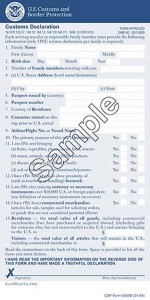We Are Family: New U.S. Custom’s Rule Liberalizes Declaration Process for Same Sex Couples and Their Families
 It was a glorious vacation out of the country. Happy but tired from travel, you begin filling out a Customs Declaration for your family on the plane home to the United States .
It was a glorious vacation out of the country. Happy but tired from travel, you begin filling out a Customs Declaration for your family on the plane home to the United States .
But wait, you wonder. Are we a family?
In the Windsor decision, the United States Supreme Court held that restricting the federal interpretation “marriage” and “spouse” — as contained in Section 3 of the Defense of Marriage Act (“DOMA”) — to apply only to heterosexual unions is unconstitutional under the Due Process Clause of the Fifth Amendment. By extension, legally married same sex couples and their children should be recognized as a family for purposes of U.S. Customs and Border Protection’s Customs Declaration.
But what about same sex couples who are in civil unions, domestic partnerships, or even those who live in states where no legal recognition of any sort is available?
Well, yesterday Customs published a new “final rule” in the Federal Register in order to “more accurately reflect relationships for U.S. citizens, residents and international visitors who are traveling together as a family.” The final rule will “broaden the definition of ‘members of a family residing in one household’ to include long-term same-sex couples and other domestic relationships,” which, Customs writes will:
allow more returning U.S. citizens, residents and international visitors to file a joint customs declaration for items acquired abroad. The regulation change will create less paperwork for people who are traveling together as a family and will streamline passenger processing, thereby increasing efficiency for CBP, airline personnel and the traveling public.
The official change in policy regulation is scheduled to take effect 30 days after its publication. The rule change was first proposed in March 2012, thanks largely to the efforts of the Family Equality Council and Immigration Equality.
Customs also anticipates that this change will “save up to $2.8 million annually in personnel time while maintaining the highest standards of security.”

